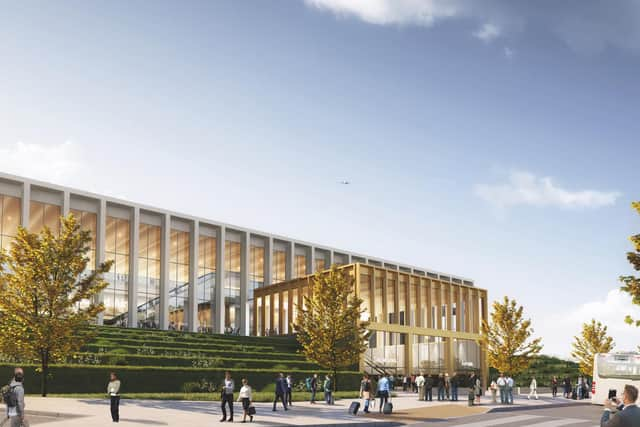This is why planners recommended Leeds Bradford Airport expansion should go ahead
and live on Freeview channel 276
A final decision is set to be made on the future of the airport at a meeting next week, following more than a year of protests and controversy around the proposals for a new £150m terminal and runway at the site in Yeadon.
Environmental campaigners and climate academics had warned flights in and out of Leeds needed to dramatically reduce in order to help humanity have a fighting chance of averting climate catastrophe in the coming years.
Advertisement
Hide AdAdvertisement
Hide AdCouncil planning officers have now set out their recommendation in a report to the authority’s City Plans Panel that suggests they approve the blueprints, albeit with 50 conditions on the developers.


The report states: “The local planning authority has had regard to the high number of comments received, both in favour and against the proposals, together with the delivery of policy and technical requirements.
“Central to the proposed scheme is the development of a well-designed, more efficient, carbon neutral replacement terminal building. This will not only be more operationally efficient but will provide a gateway to Leeds and beyond and will greatly improve the passenger and employee experience and provide higher quality welcome for travellers to the city and the region.
“Linked to this, the proposed development will bring associated economic benefits.
Advertisement
Hide AdAdvertisement
Hide Ad“The application also entails the reduction of the night time flying regime period and an increase in the number of flights as the airport looks to expand to (seven million passengers per annum) by 2030.
“The focus of this is for LBA to be on a competitive footing with other regional airports, whilst at the same time, seeking to minimise and to mitigate any adverse environmental impacts.”
“Extensive measures to improve public transport and accessibility to the airport are proposed which would reduce the proportion of travel by car, despite an overall increase in passenger numbers.”
During a meeting in September 2019, Leeds University PHD researcher Jefim Vogel gave a presentation to the council’s Climate Emergency Committee, where he claimed air passenger numbers at the airport needed to reduce by three quarters before 2030 to fend off the threat to civilisation posed by climate change.
Advertisement
Hide AdAdvertisement
Hide AdSince then, a number of protests have taken place, with campaigners famously staging a “die-in”, which disrupted a planning meeting in January 2020.
The council has also received nearly 2,000 objections to the plans themselves, although it has also received more than 1,200 in support.
The report from Leeds City Council officers said the climate impact of the new terminal itself would be lower than the current airport building, claiming the issue of carbon emissions from flights needed to be dealt with at a national level.
It added: “Any suppression of planned growth at LBA here (is) likely to lead to displacement as other airports simply taking up the demand along with the flight emissions (and without Leeds securing the economic benefits).
Advertisement
Hide AdAdvertisement
Hide Ad“Further, the carbon budget for LBA flights would still not be exceeded by the development. It has been demonstrated (without the flights), that the scheme will reduce the amount of carbon production that the existing situation which will help for Leeds to achieve its zero carbon by 2030.”
It added that “noise-mitigation” measures would include “the provision of appropriate additional insulation of properties at no cost to residents/householders.”
And, while the plans do meet the criteria for “inappropriate development” on the green belt, council officers argue this meets the test for “special circumstances, adding: “Officers have concluded that the significant economic benefits, and reduction in carbon emissions due to the new terminal and ground operations, as well as the benefits arising from improved passenger experience do clearly outweigh the harm to the Green Belt and the other harms that have been identified within the report.”
A final decision on the plans is expected to be made at a meeting of Leeds City Council’s City Plans Panel on Thursday, February 11.
Advertisement
Hide AdAdvertisement
Hide AdSome of the conditions Leeds City Council plans to put in place for the airport, should it be approved:
- Samples of materials used in the development to be submitted to the council.
- Plans for nearby landscaping to be submitted to the council, as well as a commitment for no trees, hedges, bushes or trees to be removed that are not shown on the approved plans. It adds any that die within five years must be replaced at LBA’s cost.
- Hours of construction to be 7am to 6pm Monday to Friday and 9am to 1pm on a Saturday only.
Advertisement
Hide AdAdvertisement
Hide Ad- Details of measures to treat odour and fumes from the fuel farm and refuelling activities to be submitted to the council.
- A Biodiversity Environmental Management Plan including a landscaping management plan which includes monitoring for a minimum of 30 years to be submitted.
- Separate drainage for foul and surface water.
- Nearby road works to be completed by developer prior to opening.
- A658 roundabout works to be completed prior to achieving six million passengers per year.
Advertisement
Hide AdAdvertisement
Hide Ad- Forecourt works, electric vehicle charging hubs, parking, showers, and lockers to be completed before opening.
- Several controls on night time movement and noise.
- No routine engine testing between the hours of 11pm and 7am, as well as any time on a Sunday, good Friday and Christmas day.
- LBA to pay 100 percent of the costs on the supply and installation of secondary windows or the same value as a grant towards replacement primary
windows.